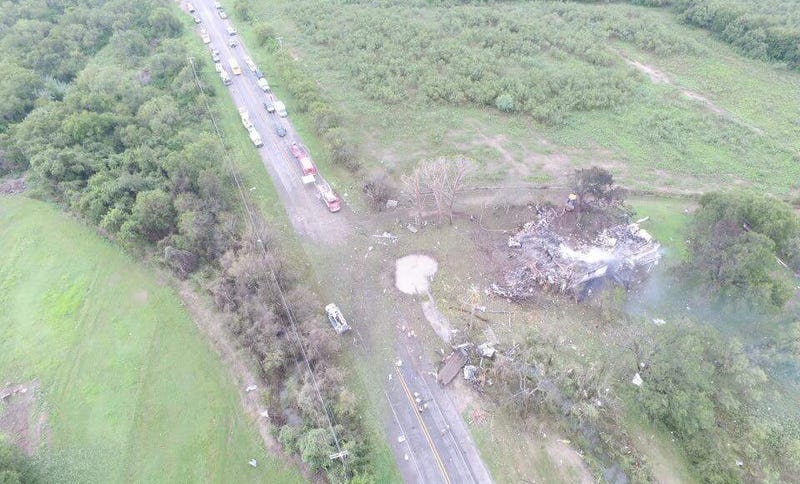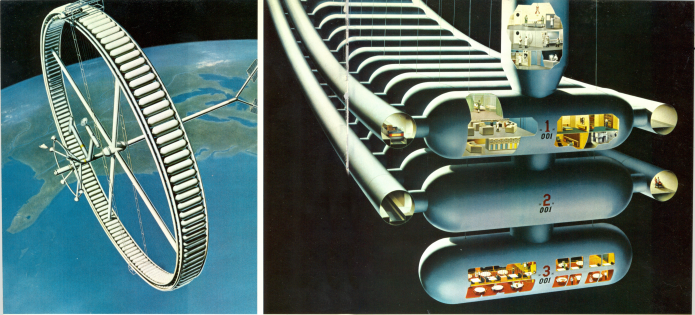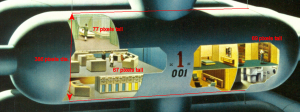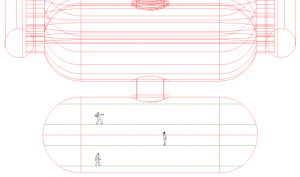This is a little old, but as important as ever:
Hmmm.
HMMMM.
Note: no primary source documentation as yet. Still…
HMMMM.
An Interesting SETI Candidate in Hercules
Data:
Star: HD164595. Near-clone of the sun, 0.99 solar masses, 91 lightyears away in the direction of Vega, one confirmed planet (a “Warm Neptune” 16 Earth masses, 40-day orbit).
Detection: RATAN-600 radio telescope in Zelenchukskaya, in the Karachay–Cherkess Republic of Russia, not far from the border with Georgia in the Caucasus.
Signal: wavelength of 2.7 cm, 750 mJy.
The signal was apparently *very* powerful. If it was a directional beam, this would mean (assuming it’s an intelligent signal) it was sent towards Earth around 1925; “they” would have been looking at Earth circa 1834. Which means “they” obviously would not have been picking up terrestrial radio signals. A sufficiently advanced astronomical culture might have been able to spot Earth telescopically, and *perhaps* took note of changes in Earths atmosphere going on at the time, indicators of an early fossil-fuel fueled industrial revolution.
The relevant paper is to be reported on at the 67th International Astronautical Congress in Guadalajara, Mexico, on Tuesday, September 27th, 2016.
Squatting in Utah: Not a good idea
I have yammered on in the past about how in Britain is had not been a crime for someone to steal your home via squatting. This changed, I believe, a few years ago. I don’t know how enthusiastically the British police may be enforcing that particular law, but Utah police? They’re on it:
Swat team sent in to arrest alleged squatters
In this case, the house they were squatting in was privately owned, but *not* occupied when the two squatters moved in. Nevertheless, the police decided to remove them and charge them with a number of offenses including burglary, a felony.
Now, I’d prefer to not have SWAT cops stomping around my place making a mess. But I’d gladly deal with the disruption, the kicked-over stuff, the bullet holes and the chalk body outlines on the floor if that meant evicting a Britain-style home invader/squatter.
PS: In bad mood tonight. On my evening walk I came across evidence of someone killing cats, at least two. Not cats I knew, but… not the way to get on my good side. Not sure what to do about it.
Enough that a truckload of ’em can do this to a nearby house:

The woman who lived in that house was missing for two days. She was finally pronounced dead when official examined “dental pieces,” which I assume means “assorted and scattered teeth.”
Truckload Of Airbag Parts Explodes En Route To Takata Plant, Killing Woman Inside Her Home
Somebody’s in trouble, I think…
Earlier this year I posted this image of a late 60’s/early 70’s Lockheed space station:

And asked if there was any hard data out there on the design. Much to my disappointment, but not to my surprise, there doesn’t seem to be any. Clearly the artist devoted a considerable amount of effort to the project… it’s not something slapped together on a whim. But it’s also likely something that got buried and may never again see the light of publicity. So some months back I decided to try to figure out just how big it was supposed to be. Fortunately there are reasonably clear humans for scale.
First off: one thing you discover real fast about the world of concept is art is Do Not Trust Scale References. Things aren’t scaled *down* too often, but things are scaled *up* with annoying frequency. Because Bigger Is Better, I suppose. Consequently, the artist here *could* have taken serious liberties; scaling things up by a factor of 1.5 or even two would not be unheard of. But… this is seemingly all there is. Without further data, you have to work with what you have.
So, starting with the cutaway image, there are a number of male human figures. Assume that the average is about 70 inches tall (for those of you in countries that *didn’t* land men on the moon, 70 inches is about 5.7621e-17 parsecs). Three figures are fairly clearly visible on the uppermost module… one is 67 pixels tall, one is 69 pixels tall and one is 77 pixels tall. The average there is 71 pixels. Thus… 71 pixels = 70 inches. For simplicity, let’s just assume that 1 pixel equals 1 inch. The diameter of the module can be estimated based on the top and bottom points of the cylinder. The top is clearly visible via the cables entering into it; the underside has similar cables which are not visible due to the module being slightly rotated. If we assume that the bottom is as far from the visible edge as the top is, that gives a diameter of 386 pixels, or 386 inches.
Interestingly, and perhaps tellingly, the diameter of the Saturn V first and second stages was 396 inches. I think it’s perhaps safe to assume that we’re looking at modules designed to be that same diameter. Drawing one of the modules in CAD by tracing over the geometry gives a module length of about 1116 inches.
Coming up next time on “Don’t You Have Anything Better To Do Theater:” the overall layout and dimensions of the space station.
You know you want it. But can you afford it?
R2-D2 Life-Size Figure

No information on features or cost yet. Available for pre-order September 1.
Currently on eBay is a vintage Greek “Biscuit Card” featuring a simplified artwork replicating an internal-detonation nuclear pulse rocketship illustrated by Frank Tinsley. The original artwork was for a magazine ad for Arma Bosch in 1959 and is *not* any sort of official engineering design, just a magazine artists impression.
I’ve never seen the biscuit card version. I’ve no idea if this was a local Greek production, or the card was published in multiple languages.
Here’s the biscuit version:
Here’s the Tinsley original.

Don’t meet me in St Louis! City tops FBI’s most dangerous list in the United States, closely followed by Memphis and former ‘Murder City’ Detroit in third
1. St. Louis, Missouri: 88.1 violent crimes per 10,000 people
2. Memphis, Tennessee: 84.2 violent crimes per 10,000 people
3. Detroit, Michigan: 83.4 violent crimes per 10,000 people
4. Birmingham, Alabama: 82.8 violent crimes per 10,000 people
5. Rockford, Illinois: 76.3 violent crimes per 10,000 people
6. Baltimore, Maryland: 67.7 violent crimes per 10,000 people
7. Stockton, California: 67.4 violent crimes per 10,000 people
8. Milwaukee, Wisconsin: 65.3 violent crimes per 10,000 people
9. Cleveland, Ohio: 61.5 violent crimes per 10,000 people
10. Hartford, Connecticut: 55.8 violent crimes per 10,000 people
11. Atlanta, Georgia had 55.7 violent crimes per 10,000 residents
12. Springfield, Massachusetts had 54.4 violent crimes per 10,000 residents
13. Anchorage, Alaska had 53.6 violent crimes per 10,000 residents
14. Tallahassee, Florida had 52.8 violent crimes per 10,000 residents
15. Odessa, Texas had 51.8 violent crimes per 10,000 residents
16. Newark, New Jersey had 50.2 violent crimes per 10,000 residents
17. Buffalo, New York had 50.2 violent crimes per 10,000 residents
18. Philadelphia, Pennsylvania had 49.1 violent crimes per 10,000 residents
19. Albuquerque, New Mexico had 48.2 violent crimes per 10,000 residents
20. Wichita, Kansas had 45.5 violent crimes per 10,000 residents
21. North Las Vegas, Nevada had 43.4 violent crimes per 10,000 residents
22. Jackson, Mississippi had 43.2 violent crimes per 10,000 residents
23. Durham, North Carolina had 42.8 violent crimes per 10,000 residents
24. New Orleans, Louisiana had 42.7 violent crimes per 10,000 residents
25. Tulsa, Oklahoma had 41.5 violent crimes per 10,000 residents
26. Pueblo, Colorado had 41.6 violent crimes per 10,000 residents
27. Des Moines, Iowa had 38.7 violent crimes per 10,000 residents
28. Salt Lake City, Utah had 38.2 violent crimes per 10,000 residents
29. Tacoma, Washington had 36.6 violent crimes per 10,000 residents
30. North Charleston, South Carolina had 34.8 violent crimes per 10,000 residents
31. Tucson, Arizona had 32.4 violent crimes per 10,000 residents
32. South Bend, Indiana had 32.2 violent crimes per 10,000 residents
33. Louisville, Kentucky had 30.2 violent crimes per 10,000 residents
34. Manchester, New Hampshire had 28.9 violent crimes per 10,000 residents
35. Providence, Rhode Island had 26.6 violent crimes per 10,000 residents
36. Norfolk, Virginia had 24.5 violent crimes per 10,000 residents
37. Billings, Montana had 21.1 violent crimes per 10,000 residents
38. Sioux Falls, South Dakota had 20.6 violent crimes per 10,000 residents
39. Lincoln, Nebraska had 17.4 violent crimes per 10,000 residents
40. Eugene, Oregon had 15.3 violent crimes per 10,000 residents
41. Fargo, North Dakota had 14.6 violent crimes per 10,000 residents
42. Boise, Idaho had 13.5 violent crimes per 10,000 residents
43. Honolulu, Hawaii had 11.6 violent crimes per 10,000 residents
I must admit surprise at seeing Salt Lake City on the list. But then, the office of Mayor has been held by a single certain political party since 1974…
In lieu of a detailed and lengthy screed about whatever is going on in the world of politics, here’s William Shatner, circa Star Trek V, talking about Captain Kirk climbing a mountain. Re-edited and set to music to become “Shatner of the Mount.”
Because you wanted this, you just didn’t know it.
Huzzah. A vaguely Earth-ish planet has been confirmed to have been detected orbiting the red dwarf Proxima Centauri, 4.25 lightyears away. It hasn’t been visually observed; detection was by way of detecting the slight wobble of Proxima (via Doppler shift) caused by the gravitational pull of the much smaller planet.
What’s known about Proxima Centauri B:
Mass is 1.3 Earths or more; 90% chance that it’s less than 3 Earth masses.
The length of the local “year” is 11.186 terrestrial days.
It’s 4.3 million miles from Proxima (about 0.046 AU)
It’s in the “habitable zone” where liquid water can exist. It gets about 65% the solar flux as Earth does.
Proxima Centauri is an unfriendly host star, with X-Ray bursts and the like that, even though the planet might be in the habitable zone, would potentially blow any atmosphere off the planet. It gets about 400 times the X-ray flux as Earth.
Not much more than that at this time. Speculations and ramblings:
If the planet is low in heavy metals, being basically just a chunk of rock, the greater mass than Earth might still result in an Earth-like surface gravity (and a noticeably larger planetary diameter).
Chances are good that it’s tidally locked to Proxima. But it might be in a resonance, such as three rotations for every two revolutions. If so, it would have some long days, but that would help it maintain proper weather patterns, rather than a perpetually frozen dark side and a day side with the atmosphere cooked off.
It *might* have a substantial moon (it’s possible that the 1.3 Earth masses might be distributed as, say, a 1 Earth mass planet and a 0.3 Earth mass moon). To pull this off, the two would have to be close. Chances would then be good that the planet might be tidally locked with the *moon.* In any case, if it has a close, massive moon, tidal forces between the moon and the star would make the planet tectonically entertaining.
If it’s a big fluffy rock… probably no magnetosphere to speak of. And thus probably no atmosphere to speak of, unless it’s a high molecular weight hellscape of burning carbon dioxide like Venus. If it has a spinning molten iron core, then maybe a good magnetosphere and some useful protection from Proximas tantrums.
Red dwarfs like Proxima have lifespans measured in *trillions* of years. So assuming phantom energy doesn’t tear the universe apart in a few billion years, Proxima will be sullenly glowing away when it is 300 times the current age of the universe. The sun will be a cold, dark black dwarf and the remaining planets flung off into the galaxy long before Proxima will have expired in about 4,000,000,000,000 years. Of course by that point Sol and Proxima will be nowhere near each other; tens or hundreds of thousands of galactic revolutions will see to it that the two systems wander far apart from each other. By the time Proxima nears its end, the galaxy will be a shadow of itself… somewhat lower in mass due to having flung stars out into the universe (unless it’s heavier due to colliding with Andromeda and the two melding together) and from mass-energy having been radiated away for trillions of years; very, very red and dark, with the only stars still burning being red dwarfs like Proxima, some younger than Proxima with still more trillions of years of life in ’em. If Proxima B still orbits Proxima, the night sky would be almost utterly black. There would be almost no other galaxies visible; they will have all wandered off over the visible horizon by that point. The only stars in the sky would be other red dwarfs… and from Earth, Proxima Centauri is invisible to the naked eye. So even though there might still be millions of red dwarfs still cooking along… you’d need a pretty good telescope to see even the closest ones.
Since Proxima is relatively cool, much more of its radiant energy is shifted towards the infra-red end of the spectrum. Someone standing on Proxima B would still see things in pretty much normal color, but the sky would look funny. With less light on the blue end of the spectrum, there’d be that much less blue light to scatter in the atmosphere, thus it’d look dark in daytime. Not sure if you’d be able to see stars in daytime, but maybe…




